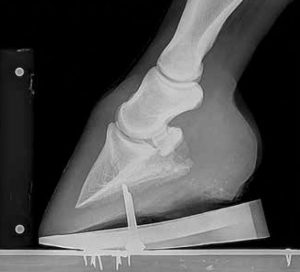
Beneath the Hoof Wall: Soft Tissue Injuries of the Equine Foot
Learn how these injuries happen, how veterinarians treat them, and tips for preventing them in the first place.

Learn how these injuries happen, how veterinarians treat them, and tips for preventing them in the first place.

Meet Beau, and follow the 8-year-old Quarter Horse’s journey from subtle lameness to return to performance.

The racing industry is leading the charge in identifying at-risk athletes before catastrophe occurs.

Veterinarians consider MRI the gold standard for diagnosing equine musculoskeletal injuries. Learn more with this visual guide. Sponsored by Hallmarq Veterinary Imaging.

New imaging techniques might make examining abnormalities of the fetlock easier for equine veterinarians.

Four diagnostic imaging experts share insight that can help owners and veterinarians with the diagnostic process.

Advancements in equine imaging have made it possible for veterinarians to better understand the anatomy and pathologies of their patients.

Diagnosing lameness in horses can be challenging, but veterinarians have an arsenal of imaging modalities available to help them make an accurate diagnosis. Sponsored by AstoCT.

Learn what to expect when your horse undergoes advanced imaging exams using MRI, CT, and nuclear scintigraphy.

Diagnostic imaging results are clearer than ever, but how they will affect a horse’s performance career isn’t always evident.

Getting to the root of podotrochlosis, one of the most common causes of lameness, is an ongoing process. Learn about risk factors for the disease and how veterinarians diagnose it.

The best diagnostic imaging tool for the cervical spine is MRI, rather than widely used radiographs.

Diagnostic imaging results are clearer than ever, but how they will affect a horse’s performance career isn’t always evident.

Read about the significance and prevalence of these injuries and how veterinarians diagnose them.

Belgian researchers use both modalities to investigate the causes of foot pain in 30 horses referred to the equine hospital for forelimb lameness.

Though it goes by several names, the condition is common among horses and frustrating for owners, farriers, and veterinarians alike.
Stay on top of the most recent Horse Health news with
© 2022 Copyright Statement dolor sit amet, consetetur sadipscing User Terms, sed diam nonumy eirmod tempor invidunt ut labore et dolore magna aliquyam erat, sed diam voluptua. At vero eos et accusam et justo duo dolores et ea rebum. Stet clita kasd gubergren, no sea takimata sanctus est Lorem ipsum dolor sit amet.
"*" indicates required fields